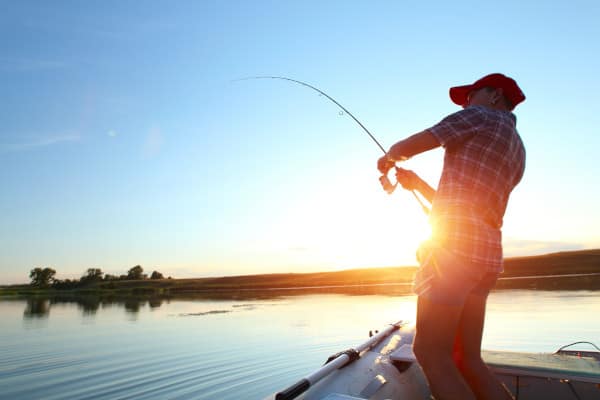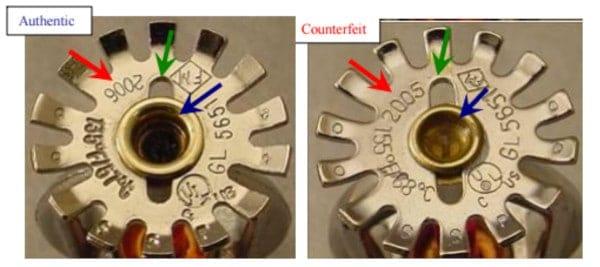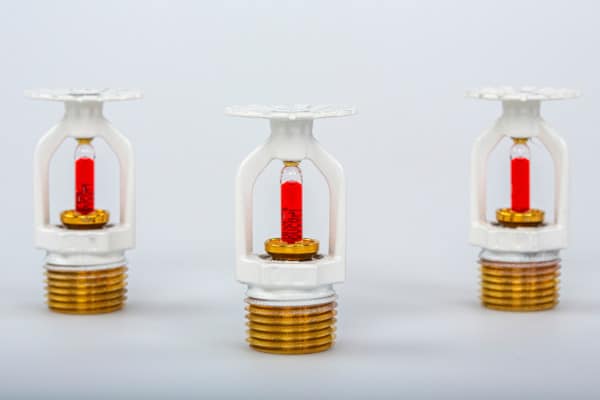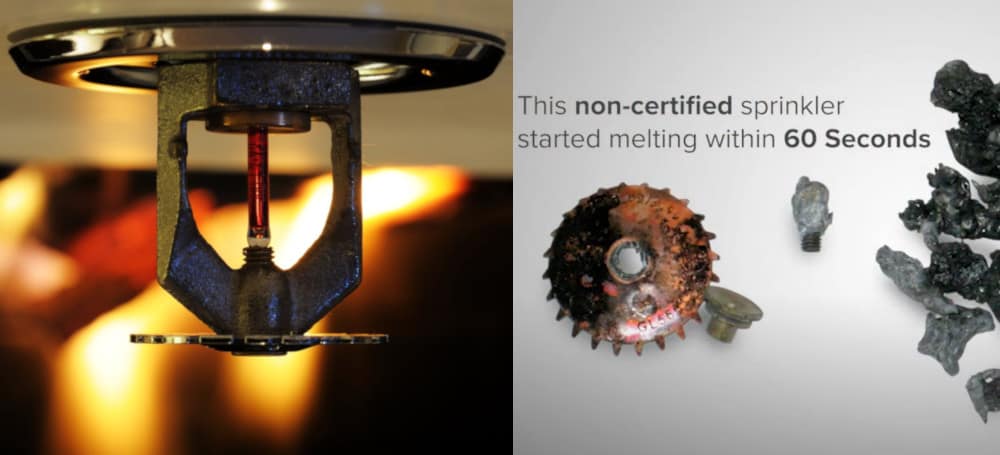Amazon still currently sells some unlisted, non-code-compliant fire sprinklers. Here’s how to avoid getting burned.
QRFS is all about easy, online access to fire sprinklers and other products. But convenience without quality is unacceptable in fire protection. Only tested, certified, and code-compliant sprinklers can ensure people and properties stay safe. Unfortunately, there are still some fire sprinklers on Amazon that aren’t up to this standard.
Here’s a look at some of the fire sprinklers currently sold by the world’s largest online retailer, examples of what may be legit and what’s definitely not, and how to avoid purchasing something questionable. We cover:
- Why fire sprinklers and other equipment must be “certified” or “listed”
- The risks of uncertified or “knock off” heads
- How to spot uncertified fire sprinklers on Amazon
- Final tip: Buy listed sprinklers from verified sources
Why fire sprinklers and other equipment must be “certified” or “listed”
Worldwide fire protection standards require fire sprinklers to be “certified.” This general term means this equipment has been tested according to specific criteria by a recognized safety organization. NFPA 13: Standard for the Installation of Sprinkler Systems and other NFPA standards describe these relevant certifications as “listed:”
From the 2022 edition of NFPA 13 (emphasis added):
3.2.3* Listed.
Equipment, materials, or services included in a list published by an organization that is acceptable to the authority having jurisdiction and concerned with evaluation of products or services […] whose listing states that either the equipment, material, or service meets appropriate designated standards or has been tested and found suitable for a specified purpose.
7.1.1.2 Unless the requirements of 7.1.1.3, 7.1.1.4, or 7.1.1.5 are met, all materials and devices essential to successful system operation shall be listed.

The need for a listing is obvious: sprinklers and other essential components must work properly during a fire. Qualified organizations test if sprinklers go off on time, whether their materials can withstand a fire’s heat, and other crucial performance characteristics.
There’s no guarantee that a noncertified/unlisted fire sprinkler will activate on time or at all, not spring a leak under system pressure, or not catastrophically fail because the frame melts.
Similar requirements apply to other fire protection equipment. For example, all cover plates for concealed sprinklers and many escutcheons (for flush or recessed installations) must be part of the “listed sprinkler assembly.” This status ensures these parts fit right and don’t block the spray of water and, in the case of covers, that they drop away properly and on time.
Read our previous blog to learn more about listings and fire protection equipment.
The risks of uncertified or “knock off” heads
Unfortunately, Amazon has a history of selling noncertified/unlisted fire protection products. In some cases, this equipment is in a grey area. For example, some unlisted escutcheons are okay in certain situations and installation types as long as they’re acceptable to the authority having jurisdiction (AHJ).
But the rules for fire sprinklers are unequivocal: an unlisted/noncertified fire sprinkler poses obvious safety risks if used in a system. It also violates legally enforceable fire codes (in North America and elsewhere) referencing installation and maintenance standards and will fail a proper fire inspection.
Back in 2020, leading industry authorities issued a warning and call to action to Amazon. The Canadian Automatic Sprinkler Association (CASA), the International Fire Suppression Alliance (IFSA), and the National Fire Sprinkler Association (NFSA) studied many of the fire sprinklers and other products sold on the site. These organizations sent a letter to Amazon detailing the items that “pose substantial risk to health, safety, and welfare.”
Some research indicates what can go wrong with dodgy sprinklers. “In 2016, the Brazilian Sprinkler Association cooperated with IFSA in the extraction of hundreds of noncertified sprinklers from two buildings in São Paulo, Brazil.” To be clear, IFSA does not state that these parts were purchased on Amazon. However, the assessments indicate what can go wrong with noncertified sprinklers.
Here are some highlights of the test results:
- Failed “lodgment tests.” These assess “potential hang-up[s] of operating parts,” such as whether the sprinkler’s plug that holds back the water will dislodge and completely fall away when the sprinkler activates. The 40 noncertified sprinklers studied had “a cumulative failure rate of 47.5%,” and “up to 100% of samples experienced a hang-up of operating parts in at least one combination of configuration and pressure.” Hang-ups can block the spray of water that needs to get to the fire and its surrounding fuel sources.

- Failed “assembly load versus frame strength” tests. IFSA assessed whether the frames allowed too much load on the fragile heat-sensitive bulbs that hold back the water. The “load on the sprinkler bulbs” was too high to adequately “prevent inadvertent water discharge in the absence of a fire.”
- Materials analysis/heat-resistance tests. The International Organization for Standardization’s “ISO 6182-1 requires sprinkler frames to withstand a temperature of 800°C (1,472°F) for 15 minutes.” But the frames of some of the tested sprinklers totally “melted away within three minutes.”
In addition, IFSA found that some sprinklers used “O-ring style water seals that have been banned from use since 2003.” And many failed “a basic test of whether a fire sprinkler can perform the job of extinguishing or controlling a fire.”
This IFSA video explains the importance of certifications and reviews some of these test results:
How to spot questionable, counterfeit, or uncertified fire sprinklers on Amazon and other online sources
NFSA, CASA, and IFSA asked Amazon to do the following in 2020:
- “Remove potentially unsafe products from the current sale offerings.”
- “Develop frameworks to ensure that the fire sprinklers and associated products offered by vendors meet legally required safety standards and are suitable for use in building fire protection systems.”
- “Establish a means to routinely scan and remove non-compliant items for sale when they occur in the future.”
An NFSA representative reports that Amazon reacted well to this challenge at the time and aggressively filtered out many unsafe products. But three years later, as of this writing, the top product results reveal some obviously uncertified fire sprinklers—and some listed ones that are a bit confusing.
We recently checked this out by typing “fire sprinklers” into the search bar on Amazon. And while we’d love to show you images of the results, copyright law is what it is—so a description will have to do.
The top five sponsored results showed one quality fire sprinkler shut-off tool and four sprinklers. Two of those sprinklers were UL-Listed, while two others were not. Here’s a review of these options:
Possibly safe, certified/listed sprinklers
Two of the results were Tuna sprinklers, a legit Chinese brand. Assuming the heads are what they say they are and their certifications are valid, various product pages reveal they are listed.
However, it may be relevant to note that in 2019, FM issued a product alert (PDF) about a “falsified [Certificate of Compliance] CoC misrepresenting Nanjing Tuna Fire Protection Co., Ltd sprinklers as FM Approved.” In response, the company “acknowledged the existence of this falsified certificate” and “issued [a] public notice” that the sprinklers weren’t FM Approved. Nevertheless, legit Tuna sprinklers are UL-Listed.
That said, it’s often important to verify that a seller on Amazon is who they say they are. Among the “Pro Tips for Shopping Safe on Amazon” offered by Wired is this one:
“Make sure there’s nothing fishy about the company name, product name, description, or images. […] It doesn’t hurt to click on the manufacturer’s name in Amazon (it should be a link) to see what else they’re selling.”
The word “fishy” is ironic here. When we clicked “Visit the Tuna store” from one of these sprinkler’s product pages to check out the seller, it took us to a shop for fishing shirts.

QRFS doesn’t carry Tuna models; we only sell fire sprinklers from what we consider the most well-known and time-tested manufacturers. And we can’t advise buying sprinklers from anywhere you can’t verify the seller’s reputation. The Tuna Store mix-up might be an issue with one of Amazon’s algorithms improperly aggregating products branded “Tuna.” These models very well could be as advertised: listed Tuna sprinklers. Nevertheless, the confusing store points to issues with knowing exactly who you are buying from.
But again, at least these fire sprinklers on Amazon publicize the necessary listings for code-compliant use.
If you purchase any seemingly legit sprinklers and aren’t 100% certain about their validity when they arrive, check the updated product advisories from testing and certification agencies. Here are the two most relevant resources in North America:
You may also contact these organizations directly with questions or reports, or physically compare a sprinkler you’ve purchased with another model from somewhere you trust. Many of the bulletins issued by FM, UL, and others provide side-by-side comparisons showing what is off about known problems:

That said, the product alerts and notices only reveal known and reported issues. And the effort to verify sprinklers is a hassle compared to simply buying them from trusted sources.
Then there are the other ‘fire sprinklers’ sold on Amazon. In these cases, there’s no question that the heads are noncertified and not legal for use in code-compliant systems:
Clearly noncertified/unlisted fire sprinklers on Amazon
It’s hard to know where to begin describing what’s wrong with two of the product pages that showed up in the top five Amazon search results, sold under the brand “Bestopper.”
Off the bat, one classifies its “fire sprinkler” as a “home/garden/irrigation” product. This could be how the seller avoids whatever measures Amazon has in place to filter out noncertified fire protection products.
However, the details on the page include this bit (emphasis added): “Widely installed indoor (home/factory/school/office etc.), and also works on farm and garden for plants irrigation.” Does that highlighted statement—in addition to calling it a “fire sprinkler”—imply fire protection use?

These ‘fire sprinklers’ claim no certifications, listings, or approvals. The product pages have various mild grammatical and formatting errors, along with some odd language. For example, we’re unsure what they mean by a “nozzle” or “protective nozzle cover” in this context.
And while the seller states the sprinklers are made of brass (which parts?), the lack of testing and certifications means you can’t be confident they won’t melt in a fire—or that the sprinklers will work at all. QRFS has ordered some noncertified sprinklers from Amazon to check them out. And while the ones we purchased claimed to be brass, they were very light—you can feel the weight difference in your hand.
So, look out for the following when examining fire sprinklers on Amazon:
- No “UL-Listed,” “FM-Approved,” or other internationally accepted certification
- Mentions other uses that are not fire protection
- Spelling and grammatical errors
- The use of odd terms not suited for the product
If red flags are waving, particularly the first one, it is not a suitable fire sprinkler, nor one that can ethically, morally, or legally be used in code-compliant systems.
Installing noncertified fire sprinklers that fail during a fire could get people killed.

Buy quality, certified/listed fire sprinklers from verified sellers and manufacturers
QRFS obviously has an incentive to point out problems with Amazon’s current catalog of fire protection equipment. We’re an online retailer, so are they. But please put that aside for a moment.
We are far less concerned with whether you purchase from Amazon, QRFS, another reputable seller, fire protection contractors, or the manufacturers themselves than safety. The rule remains the same: DO NOT buy noncertified/unlisted fire sprinklers—unless maybe you plan to break the heat-sensitive glass bulbs and just use them to water plants. (But we’d go with actual lawn and garden sprinklers, there.)
QRFS echoes the call to action issued by CASA, IFSA, and NFSA in 2020, and we hope Amazon successfully removes uncertified fire sprinklers and additional parts without the required listings from the site.
Otherwise: Always verify the seller is who they say they are. Ensure fire sprinklers and other fire protection equipment have the appropriate certifications, listings, and approvals. If you have doubts about any sprinklers, check the latest product warnings and bulletins. Do not leave protecting people and property to chance.
Check out our previous blog to learn about past issues with counterfeit fire sprinklers and certifications—and how to identify them.
Have any questions? Contact us at 888-361-6662 or support@qrfs.com.
This blog was originally posted at blog.qrfs.com. If this article helped you, check us out at Facebook.com/QuickResponseFireSupply or on Twitter @QuickResponseFS.



This is becoming more of a problem than I would have imagined. We run into instances where non-certified products, especially sprinkler heads for some reason, have been installed.
Tyler — Thanks for your input and perspective! Educating people about listings/certifications is key.